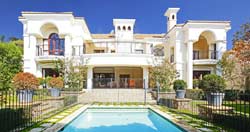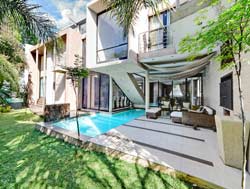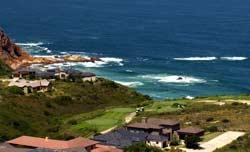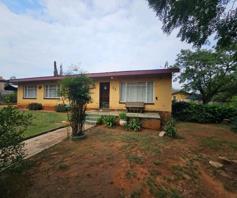Price growth in the South African housing market slowed down further in July, according to the Absa House Price Index report, which shows that middle-segment house price growth recorded nominal growth of 9.8 percent year-on-year (y/y) in July from 10.8 percent y/y in June.

This Sandton cluster home is on the market through Pam Golding Properties for R9.5 million.
The first seven months of 2013 saw the value of middle-segment homes rising by an average 10.8 percent y/y.
Writing in the report, Jacques du Toit, Absa Home Loans property analyst says the slowdown in y/y price growth continued in the categories of small and medium-sized housing, while price growth in the segment for large homes appears to be near an upper turning point.
The average nominal value of small homes (measuring 80 to 140 square metres) was R742 600, medium-sized homes (141 to 220 square metres) was R1 064 900 and large homes (measuring 221 to 400 square metres) was R1 697 900.
“The performance of and prospects for the residential property market will continue to be closely related to economic growth, employment and household income growth, property running costs and living costs in general, interest rates, consumers’ credit-risk profiles, consumer confidence and banks’ risk appetite and lending criteria,” says Du Toit.
He says these factors will impact the affordability of housing and mortgage finance and will be reflected in property demand and supply conditions, price trends, market activity, buying trends, transaction volumes and the demand for mortgage finance.
“House price growth nominal prices are forecast to show single-digit growth for the full year.”
Buying and renting property in Sandton
Be that as it may, Pam Golding Properties (PGP) in Hyde Park Johannesburg points out that the Sandton residential property market remains robust attracting buy-to-let investors as demand for rental accommodation soars.
Joint area manager for PGP, Jonathan Davies, notes that property developments in the area are driven by the rapid development of businesses, office blocks, premier hotels and upmarket apartment complexes in the area.
Davies points out that the residents of Johannesburg are today showing a preference for living closer to their places of work so that they do not have to travel for long periods every day.
“They are opting rather for convenience, which means looking for homes situated closer to transport routes or to the Sandton business district.”

BetterBond reports that the national average home price has shown positive growth of 9.3 percent in the year to end-June, compared with just 3.7 percent in the previous 12 months while the average home price increased by just 1 percent in the June quarter, compared with a 6.6 percent increase in the first quarter of this year.
In some instances people have retained their properties in far off suburbs and taken second, smaller homes or apartments near to or even within the Sandton city centre, which they use during the week. This has only added to the demand for homes in the area, he says.
No surprises there perhaps as Johannesburg has emerged as the number one city where African millionaires prefer to reside.
According to New World Wealth research, Johannesburg tops the African cities with 23 400 millionaires living in the city.
Read the article here.
Johannesburg’s luxury home locations such as the Sandhurst, Bryanston and Westcliff are home to ultra high net worth individuals owning homes which cost as much as R52 million.
Davies says within the Sandton CBD itself the continued demand for accommodation has created a situation where densification is becoming increasingly evident.
This has resulted in the development of large high-rise executive apartments rather than the traditional townhouse complexes. The Michelangelo and Sandhurst Towers are examples of such developments.
“A Sandton address remains a prestigious one and properties here are considered an excellent investment,” says Davies.
He points out that the greater Sandton area is home to some of the wealthiest individuals in South Africa and well-known for its many designer-built luxury homes with their magnificently tended gardens.
These upmarket properties can fetch up to R20 million or more.
Sandton does offer a number of options including family homes, townhouse simplexes and apartments and in suburbs such as Morningside, Sandown, Bryanston, Rivonia, Riverclub for example, one can find a home that will suit their needs and budgets.
Family homes are priced between R2 million and R20 million while townhouses can fetch anything between R800 000 and R5 million. Executive apartments in the CBD of Sandton have been listed for as much as R60 million.
Meanwhile, PGP Hyde Park joint area manager Rupert Finnemore says that the rental market in the Sandton area is very buoyant pointing out that rentals are not only popular with local executives but also with overseas business people who work in the area and appreciate its centrality.

On the market for R2.99 million, this four bedroom home is perfectly positioned in the heart of Hillcrest with easy access to amenities such as the local school, shops and freeway. It is selling through RE/MAX Address.
“As a result of the great demand for accommodation in or near to Sandton rental properties in the area have performed well over the last number of years and this has in turn attracted a number of property investors who buy to let.”
“Sandton itself offers a great diversity of properties and rich opportunities and we expect it to remain so into the foreseeable future,” says Finnemore.
Recently, Seeff Sandton noted increased demand for rental properties in Sandton Central driven by rapid commercial developments.
As a sought-after property location, rentals come at a premium and tenants are reportedly paying rentals of between R8 000 and R20 000 per month for unfurnished apartments.
House price growth
The Standard Bank House Price Index improved by 8.0 percent in July from 7.8 percent in June.
The nominal index growth for freehold properties recorded a 10.1 percent y/y improvement in July, from 9.8 percent y/y in June while sectional title units registered improvement of 4.2 percent y/y in July, from 3.4 percent y/y in June.
Writing in the report, Sibusiso Gumbi, Standard Bank property research strategist, says the extent of household indebtedness as well as poor creditworthiness would conspire to dilute the full benefits offered by a low interest rate environment.
“We expect the repo rate (and by extension the prime rate) to remain unchanged in 2013 but we are unlikely to see a sustained double-digit rise in the house price index growth,” says Gumbi.
BetterBond reports that the national average home price has shown positive growth of 9.3 percent in the year to end-June, compared with just 3.7 percent in the previous 12 months while the average home price increased by just 1 percent in the June quarter, compared with a 6.6 percent increase in the first quarter of this year.
According to Rudi Botha, BetterBond chairman, this illustrates the dampening effect that high cost-of-living increases are having on the real estate market.
In the past three months, the extra funds injected into household budgets by January salary increases and February personal tax cuts have been absorbed by sharp increases in the cost of transport (especially fuel) and utilities (especially electricity).

Pam Golding Properties is marketing this Morningside property for R9.999 million.
As a result, he says consumers are struggling to make ends meet, and while the demand for property remains high, the decline in disposable incomes is putting a lid on what potential buyers are able to afford – and what banks are prepared to lend them, he says.
FNB, recently revealed price stability in holiday markets but no fireworks to get excited about.
The report shows that in early early-2007, holiday home buying was estimated to be around 5 percent of total home buying and Q2 2013 shows a 2 percent estimate.
Holiday and coastal property
Although holiday home buying activity is slowing, investors and leisure home buyers are making a slow comeback in the Garden Route.
According to Charles Erasmus, Seeff Pezula agent, for the first time in three years, vacant plots in the Pezula developments are starting to sell and, rather fast.
Erasmus sold three plots in quick succession measuring between 600 and 1 005 square metres and priced between R350 000 and R800 000 to a young black diamond from Gauteng and two foreigners from Europe.
The developments (Pezula Golf Estate and the Pezula Private Eco Estate) are located about 10 minutes from the centre of Knysna and easily accessible from the inland provinces via road or the Cape Town International airport and the regional George airport that offers a direct link from Cape Town and Johannesburg.
Since 2007, about 157 sales transactions worth almost R294 million have taken place in the two developments.
Most of the sales have been vacant plots and on the golf estate, complete homes in the more affordable, entry level price bands of R3 million to R4 million, says Erasmus.
“In the last few months however, we have seen renewed interest and are working with a number of buyers, mostly from the greater Johannesburg area who are ready to invest.”
According to Lightstone Residential Property Indices, the estimate for national property inflation was 6.88 percent for June which is slightly down from the previous month.
Over the past year and a half it has been observed that the coastal and non-coastal house price inflation has been diverging.
This trend is ever more apparent with the latest y/y inflation estimate for coastal properties at 3.6 percent and that of non-coastal properties at 6.69 percent, according to the report.

Erasmus sold three plots in quick succession measuring between 600 and 1 005 square metres and priced between R350 000 and R800 000 to a young black diamond from Gauteng and two foreigners from Europe.
Furthermore, due to the coastal property market being partly driven by holiday homes, the divergence in the house price inflation of these two categories of properties is not uncommon and was very apparent during the housing boom in 2004.
During this period the average year on year inflation of coastal properties was estimated at 50 percent and that of non-coastal properties at 33 percent.
In Hillcrest in KwaZulu-Natal, the average price of a sectional title unit in the area has been fairly stable over the last 10 years, fluctuating between R938 000 and R1.262 million from 2007 up until this year, says Adrian Goslett, chief executive officer of RE/MAX of Southern Africa.
The average price of a freehold home has increased to R1 664 million from R1.128 million in 2006.
According to Myles Wakefield, chief executive officer of Wakefields Real Estate, in the past year house prices in South Africa have grown by 11.1 percent which, according to The Economist, places the country third out of 18 countries sampled.
Hong Kong, up by 24.5 percent, showed the biggest house price growth and Brazil the second biggest at 12.8 percent.
He notes that, according to FNB’s recent property price index the national annual percentage change in property prices in 2010, 2011 and 2012 has been 5.9 percent, 3.3 percent and 5.1 percent respectively and the forecasts is a 2.6 percent increase in 2013.
“KwaZulu-Natal estate agents are experiencing a price rise somewhere between the Economist’s and FNB’s figures with variances within and between areas.”
He says in parts of the province there is a serious shortage of stock to sell and to rent, pointing out that in certain areas of Westville, for the first time, they have very little stock in the under R2 million price range.
“If we sold a property for R2 million three years ago we would have been elated, now it is a fairly regular occurrence and yes, prices have moved,” says Wakefield.

The average nominal value of small homes ( measuring 80 to 140 square metres) was R742 600, medium-sized homes (141 to 220 square metres) was R1 064 900 and large homes (measuring 221 to 400 square metres) was R1 697 900.
Wakefield says the property market is better than people believe and this is not a yesterday phenomenon.
It has been this way for almost two years when Wakefields first reported a shortage of rental property that spread to a shortage of property for sale.
Pretoria East home values
While some buyers leave Gauteng for coastal areas and lifestyles, some find Pretoria appealing, particularly the eastern suburbs which have seen increase in home values.
Goran Despot, owner of the RealNet Erasmuskloof real estate franchise, reports some suburbs are showing exceptional price growth.
For example, Sterrewag, bordered by Monument Park and Waterkloof Ridge show price growth of between 10 and 15 percent in some residential complexes thanks to increased demand.
“It is fast becoming a sellers' market here and serious sellers are confident of getting offers on well-priced homes because excess stock has now been taken up.”
He says two bedroom sectional title units measuring 62 square metres are priced up to R965 000 compared to selling prices of around R850 000 just six months ago.
Rental demand is also high with sectional title units in secure complexes commanding rentals of R6 500 for a two bedroom unit and R8 500 for a three bedroom unit per month.
“Investors can expect rental returns of up to 8.5 percent at the moment but the big attraction is the expected growth in property values over the next five to 10 years,” he says.
Meanwhile, property values are said to have increased in the Johannesburg CBD and there is a potential of demand likely to exceed supply for some time to come.
Rawson Property Franchisees Bongiwe and Phumelele Madala say there has been a huge influx of people from outlying areas into this precinct, as a result, they have, for example, in ten years seen a commercial property on the fifth floor of a CBD building, which was sold originally for R1 million increase in value to R5 million. Similarly, a small R50 000 apartment increased in value to R300 000.
“Many of these units were probably originally under-priced because investors at one stage had little faith in the CBD, however, their upswing in value has exceeded all expectations and has been ‘the big surprise on the Gauteng property scene.” – Denise Mhlanga









